Taeuk Kim
RAISE: Enhancing Scientific Reasoning in LLMs via Step-by-Step Retrieval
Jun 10, 2025Abstract:Scientific reasoning requires not only long-chain reasoning processes, but also knowledge of domain-specific terminologies and adaptation to updated findings. To deal with these challenges for scientific reasoning, we introduce RAISE, a step-by-step retrieval-augmented framework which retrieves logically relevant documents from in-the-wild corpus. RAISE is divided into three steps: problem decomposition, logical query generation, and logical retrieval. We observe that RAISE consistently outperforms other baselines on scientific reasoning benchmarks. We analyze that unlike other baselines, RAISE retrieves documents that are not only similar in terms of the domain knowledge, but also documents logically more relevant.
Does Localization Inform Unlearning? A Rigorous Examination of Local Parameter Attribution for Knowledge Unlearning in Language Models
May 22, 2025Abstract:Large language models often retain unintended content, prompting growing interest in knowledge unlearning. Recent approaches emphasize localized unlearning, which restricts parameter updates to specific regions in an effort to remove target knowledge while preserving unrelated general knowledge. However, their effectiveness remains uncertain due to the lack of robust and thorough evaluation of the trade-off between the competing goals of unlearning. In this paper, we begin by revisiting existing localized unlearning approaches. We then conduct controlled experiments to rigorously evaluate whether local parameter updates causally contribute to unlearning. Our findings reveal that the set of parameters that must be modified for effective unlearning is not strictly determined, challenging the core assumption of localized unlearning that parameter locality is inherently indicative of effective knowledge removal.
Memorization or Reasoning? Exploring the Idiom Understanding of LLMs
May 22, 2025Abstract:Idioms have long posed a challenge due to their unique linguistic properties, which set them apart from other common expressions. While recent studies have leveraged large language models (LLMs) to handle idioms across various tasks, e.g., idiom-containing sentence generation and idiomatic machine translation, little is known about the underlying mechanisms of idiom processing in LLMs, particularly in multilingual settings. To this end, we introduce MIDAS, a new large-scale dataset of idioms in six languages, each paired with its corresponding meaning. Leveraging this resource, we conduct a comprehensive evaluation of LLMs' idiom processing ability, identifying key factors that influence their performance. Our findings suggest that LLMs rely not only on memorization, but also adopt a hybrid approach that integrates contextual cues and reasoning, especially when processing compositional idioms. This implies that idiom understanding in LLMs emerges from an interplay between internal knowledge retrieval and reasoning-based inference.
KGMEL: Knowledge Graph-Enhanced Multimodal Entity Linking
Apr 21, 2025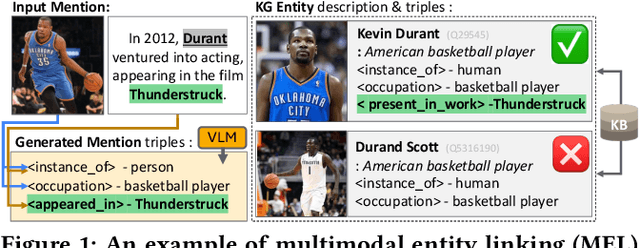



Abstract:Entity linking (EL) aligns textual mentions with their corresponding entities in a knowledge base, facilitating various applications such as semantic search and question answering. Recent advances in multimodal entity linking (MEL) have shown that combining text and images can reduce ambiguity and improve alignment accuracy. However, most existing MEL methods overlook the rich structural information available in the form of knowledge-graph (KG) triples. In this paper, we propose KGMEL, a novel framework that leverages KG triples to enhance MEL. Specifically, it operates in three stages: (1) Generation: Produces high-quality triples for each mention by employing vision-language models based on its text and images. (2) Retrieval: Learns joint mention-entity representations, via contrastive learning, that integrate text, images, and (generated or KG) triples to retrieve candidate entities for each mention. (3) Reranking: Refines the KG triples of the candidate entities and employs large language models to identify the best-matching entity for the mention. Extensive experiments on benchmark datasets demonstrate that KGMEL outperforms existing methods. Our code and datasets are available at: https://github.com/juyeonnn/KGMEL.
Reliability Across Parametric and External Knowledge: Understanding Knowledge Handling in LLMs
Feb 19, 2025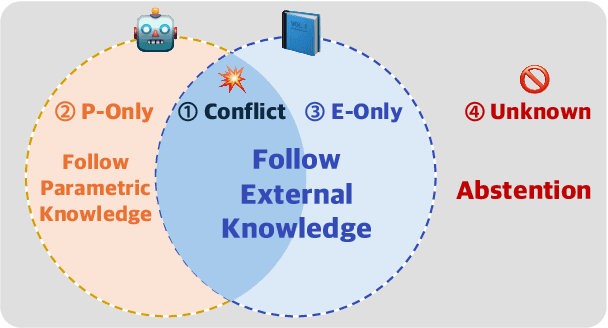
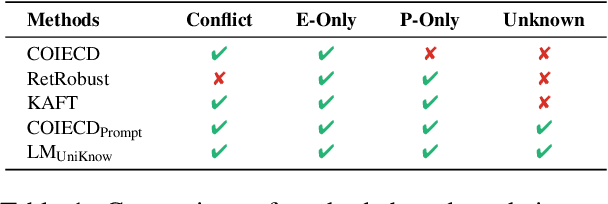

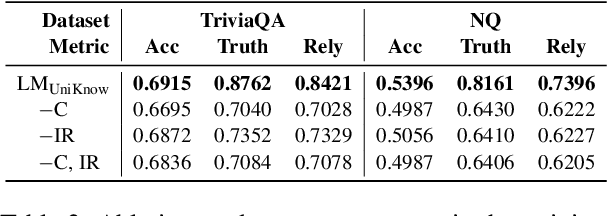
Abstract:Large Language Models (LLMs) enhance their problem-solving capability by leveraging both parametric and external knowledge. Beyond leveraging external knowledge to improve response accuracy, they require key capabilities for reliable knowledge-handling: resolving conflicts between knowledge sources, avoiding distraction from uninformative external knowledge, and abstaining when sufficient knowledge is unavailable. Prior studies have examined these scenarios in isolation or with limited scope. To systematically evaluate these capabilities, we introduce a comprehensive framework for analyzing knowledge-handling based on two key dimensions: the presence of parametric knowledge and the informativeness of external knowledge. Through analysis, we identify biases in knowledge utilization and examine how the ability to handle one scenario impacts performance in others. Furthermore, we demonstrate that training on data constructed based on the knowledge-handling scenarios improves LLMs' reliability in integrating and utilizing knowledge.
When to Speak, When to Abstain: Contrastive Decoding with Abstention
Dec 17, 2024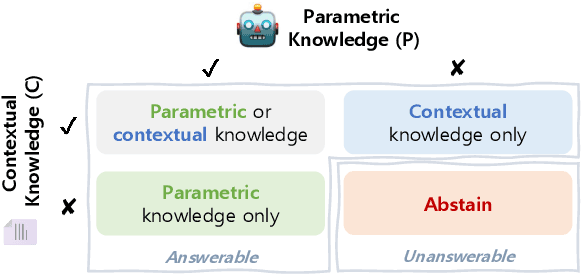
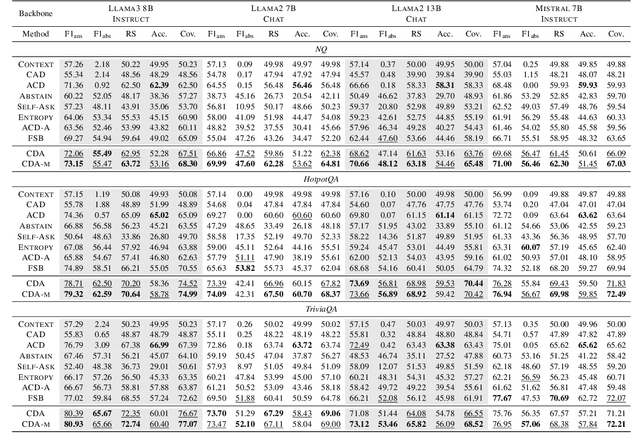

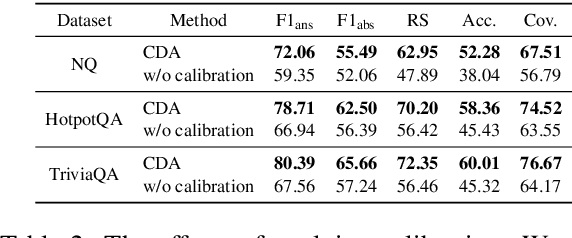
Abstract:Large Language Models (LLMs) demonstrate exceptional performance across diverse tasks by leveraging both pre-trained knowledge (i.e., parametric knowledge) and external knowledge (i.e., contextual knowledge). While substantial efforts have been made to leverage both forms of knowledge, scenarios in which the model lacks any relevant knowledge remain underexplored. Such limitations can result in issues like hallucination, causing reduced reliability and potential risks in high-stakes applications. To address such limitations, this paper extends the task scope to encompass cases where the user's request cannot be fulfilled due to the lack of relevant knowledge. To this end, we introduce Contrastive Decoding with Abstention (CDA), a training-free decoding method that empowers LLMs to generate responses when relevant knowledge is available and to abstain otherwise. CDA evaluates the relevance of each knowledge for a given query, adaptively determining which knowledge to prioritize or which to completely ignore. Extensive experiments with four LLMs on three question-answering datasets demonstrate that CDA can effectively perform accurate generation and abstention simultaneously. These findings highlight CDA's potential to broaden the applicability of LLMs, enhancing reliability and preserving user trust.
FCMR: Robust Evaluation of Financial Cross-Modal Multi-Hop Reasoning
Dec 17, 2024Abstract:Real-world decision-making often requires integrating and reasoning over information from multiple modalities. While recent multimodal large language models (MLLMs) have shown promise in such tasks, their ability to perform multi-hop reasoning across diverse sources remains insufficiently evaluated. Existing benchmarks, such as MMQA, face challenges due to (1) data contamination and (2) a lack of complex queries that necessitate operations across more than two modalities, hindering accurate performance assessment. To address this, we present Financial Cross-Modal Multi-Hop Reasoning (FCMR), a benchmark created to analyze the reasoning capabilities of MLLMs by urging them to combine information from textual reports, tables, and charts within the financial domain. FCMR is categorized into three difficulty levels-Easy, Medium, and Hard-facilitating a step-by-step evaluation. In particular, problems at the Hard level require precise cross-modal three-hop reasoning and are designed to prevent the disregard of any modality. Experiments on this new benchmark reveal that even state-of-the-art MLLMs struggle, with the best-performing model (Claude 3.5 Sonnet) achieving only 30.4% accuracy on the most challenging tier. We also conduct analysis to provide insights into the inner workings of the models, including the discovery of a critical bottleneck in the information retrieval phase.
Adaptive Contrastive Decoding in Retrieval-Augmented Generation for Handling Noisy Contexts
Aug 02, 2024Abstract:When using large language models (LLMs) in knowledge-intensive tasks, such as open-domain question answering, external context can bridge a gap between external knowledge and LLM's parametric knowledge. Recent research has been developed to amplify contextual knowledge over the parametric knowledge of LLM with contrastive decoding approaches. While these approaches could yield truthful responses when relevant context is provided, they are prone to vulnerabilities when faced with noisy contexts. We extend the scope of previous studies to encompass noisy contexts and propose adaptive contrastive decoding (ACD) to leverage contextual influence effectively. ACD demonstrates improvements in open-domain question answering tasks compared to baselines, especially in robustness by remaining undistracted by noisy contexts in retrieval-augmented generation.
Subgraph-Aware Training of Text-based Methods for Knowledge Graph Completion
Jul 19, 2024



Abstract:Fine-tuning pre-trained language models (PLMs) has recently shown a potential to improve knowledge graph completion (KGC). However, most PLM-based methods encode only textual information, neglecting various topological structures of knowledge graphs (KGs). In this paper, we empirically validate the significant relations between the structural properties of KGs and the performance of the PLM-based methods. To leverage the structural knowledge, we propose a Subgraph-Aware Training framework for KGC (SATKGC) that combines (i) subgraph-aware mini-batching to encourage hard negative sampling, and (ii) a new contrastive learning method to focus more on harder entities and harder negative triples in terms of the structural properties. To the best of our knowledge, this is the first study to comprehensively incorporate the structural inductive bias of the subgraphs into fine-tuning PLMs. Extensive experiments on four KGC benchmarks demonstrate the superiority of SATKGC. Our code is available.
Revisiting the Impact of Pursuing Modularity for Code Generation
Jul 16, 2024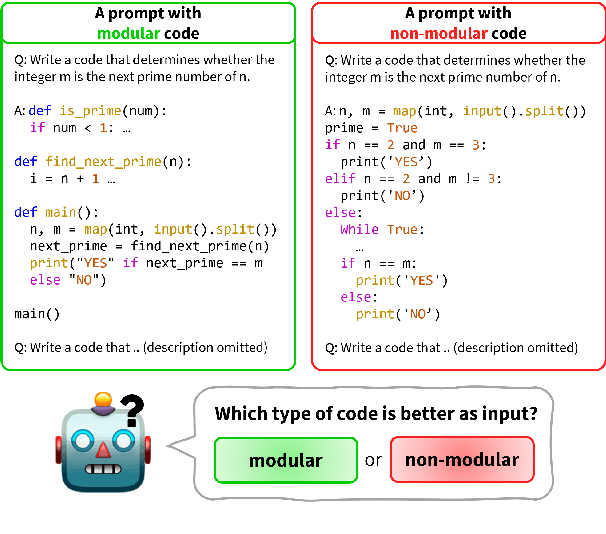

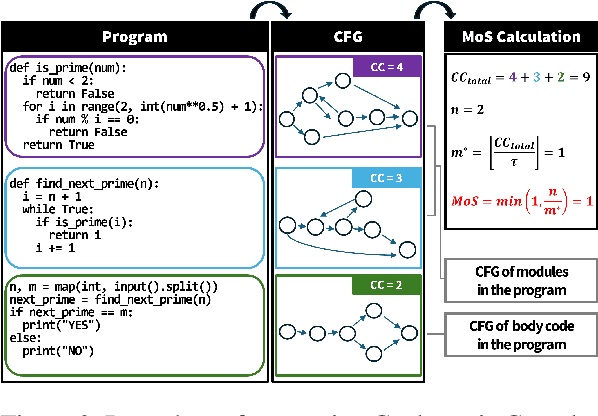
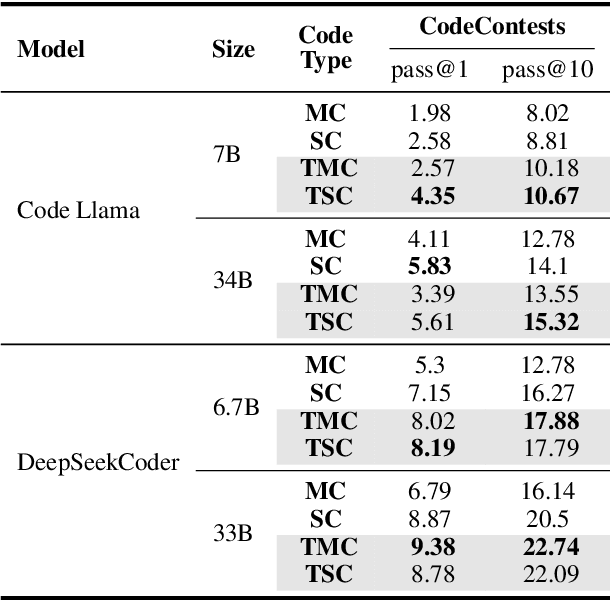
Abstract:Modular programming, which aims to construct the final program by integrating smaller, independent building blocks, has been regarded as a desirable practice in software development. However, with the rise of recent code generation agents built upon large language models (LLMs), a question emerges: is this traditional practice equally effective for these new tools? In this work, we assess the impact of modularity in code generation by introducing a novel metric for its quantitative measurement. Surprisingly, unlike conventional wisdom on the topic, we find that modularity is not a core factor for improving the performance of code generation models. We also explore potential explanations for why LLMs do not exhibit a preference for modular code compared to non-modular code.
 Add to Chrome
Add to Chrome Add to Firefox
Add to Firefox Add to Edge
Add to Edge